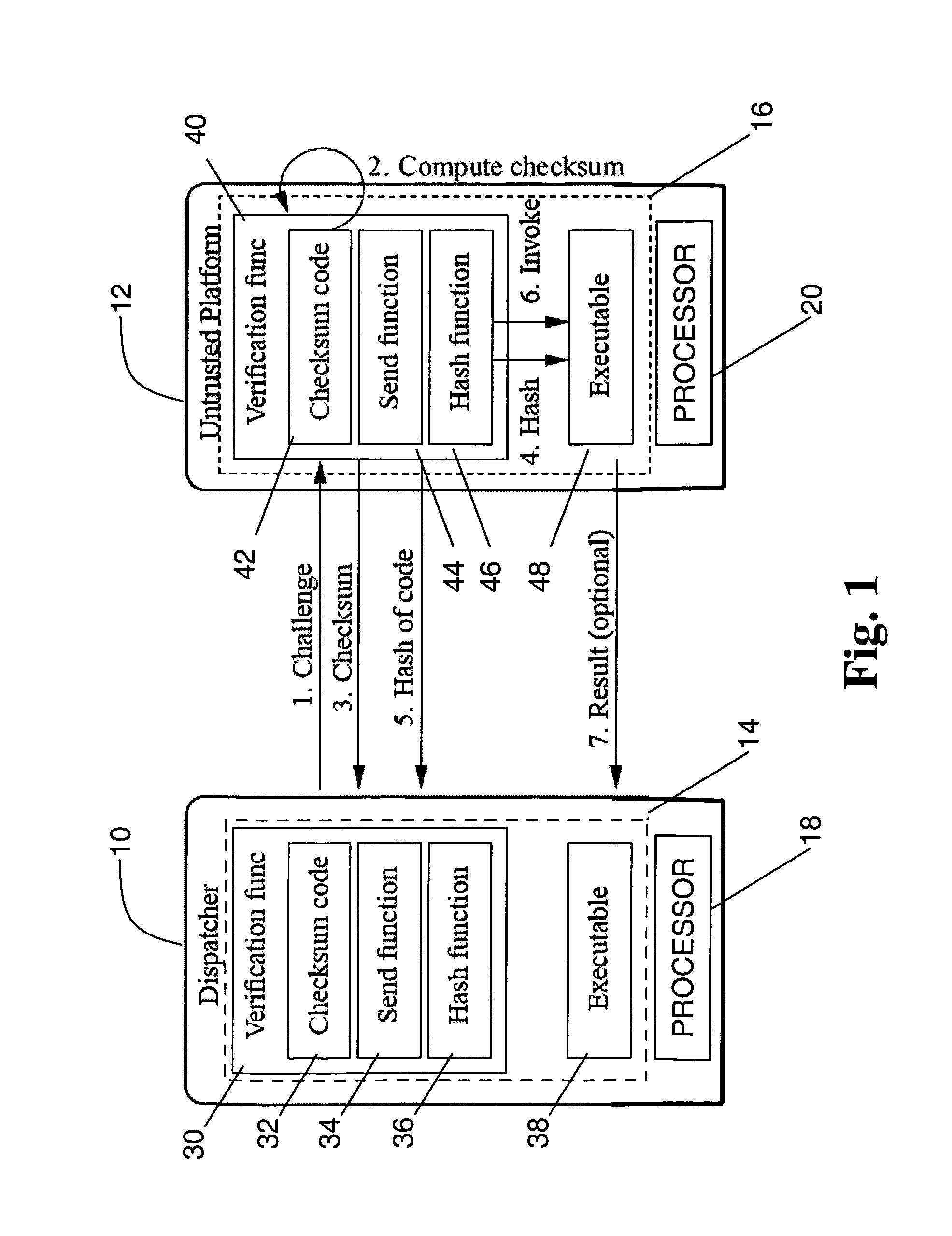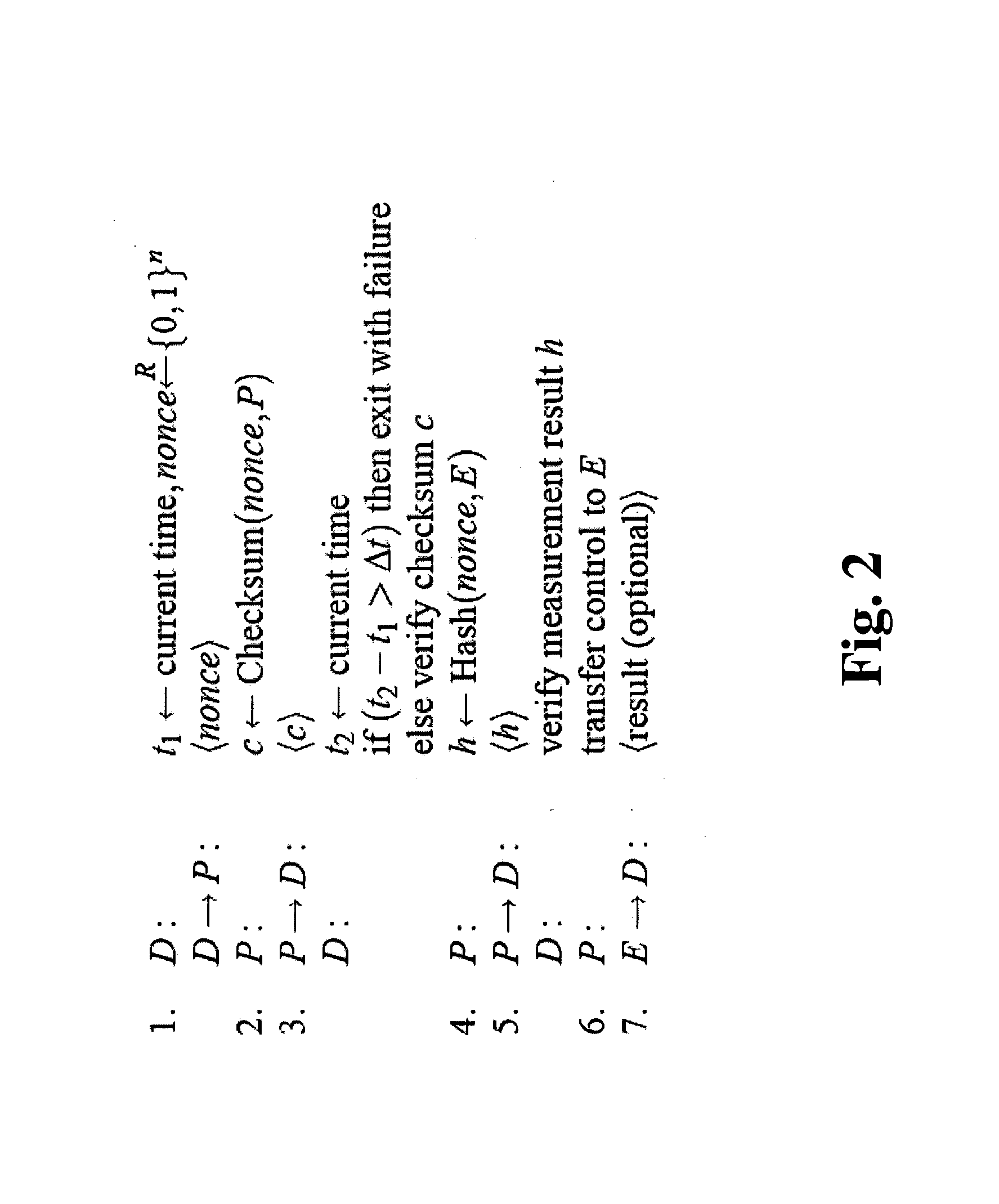Verifying integrity and guaranteeing execution of code on untrusted computer platform
a technology of untrusted computers and verification integrity, applied in computing, instruments, electric digital data processing, etc., can solve the problems of only obtaining the guarantee, unmodified code in the memory of an untrusted computer, and both these technologies are not suitable for legacy computers
- Summary
- Abstract
- Description
- Claims
- Application Information
AI Technical Summary
Benefits of technology
Problems solved by technology
Method used
Image
Examples
first embodiment
1.1 First Embodiment
[0058]In the first embodiment, the present invention includes a software-based primitive called Pioneer which is directed to addressing the problem of verifiable code execution on legacy computing platform without relying on secure co-processors or CPU architecture extensions such as virtualization support. Pioneer is based on a challenge-response protocol between external trusted entities, called dispatchers, and an untrusted computing platform, called the untrusted platform. To simplify understanding, in what follows we consider the case where there is only one dispatcher. One can easily extend our description based on one dispatcher to multiple dispatchers. The dispatcher communicates with the untrusted platform over a communication link, such as a network connection. After a successful invocation of Pioneer, the dispatcher obtains assurance that: 1) an arbitrary piece of code, called the executable, on the untrusted platform is unmodified; 2) the unmodified e...
second embodiment
2.1 Second Embodiment
[0224]Another embodiment of the present invention will be described in the context of sensor networks, although it is also applicable to computer networks and other types of networks, and not limited to “sensor networks”. This embodiment will be described in terms of “base station” and “sensor node”, or in terms of “verifier” and “device”, although those terms are analogous to, and may be replaced with, terms such as “trusted computer” and “untrusted computer”, as described hereinabove. Sensor networks are expected to be deployed in the near future in a variety of safety-critical applications such as critical infrastructure protection and surveillance, military applications, fire and burglar alarm systems, home and office automation, inventory control systems, and many medical applications such as patient monitoring. Sensor nodes in a sensor network typically run identical software. Vulnerabilities in the sensor node 104 software, like buffer overflows, leave al...
third embodiment
3.1. Third Embodiment
[0319]Another embodiment of the present invention will be described in the context of sensor networks, although it is also applicable to computer networks and other types of networks, and not limited to “sensor networks”. Sensor networks are expected to be deployed in the near future in many safety-critical applications such as critical infrastructure protection and surveillance, alarm systems, home and office automation, inventory control systems, and many medical applications such as patient monitoring. Hence, if an attacker injects malicious code into the sensor nodes, it can compromise the safety and privacy of users. We consider the setting of a sensor network where an attacker has compromised sensor nodes by injecting malicious code into their memory. The base station wants to verify the code memory contents of the nodes, and either repair the nodes by undoing any changes made by the attacker or blacklist the nodes which cannot be repaired.
[0320]FIG. 26 il...
PUM
 Login to View More
Login to View More Abstract
Description
Claims
Application Information
 Login to View More
Login to View More - R&D
- Intellectual Property
- Life Sciences
- Materials
- Tech Scout
- Unparalleled Data Quality
- Higher Quality Content
- 60% Fewer Hallucinations
Browse by: Latest US Patents, China's latest patents, Technical Efficacy Thesaurus, Application Domain, Technology Topic, Popular Technical Reports.
© 2025 PatSnap. All rights reserved.Legal|Privacy policy|Modern Slavery Act Transparency Statement|Sitemap|About US| Contact US: help@patsnap.com



